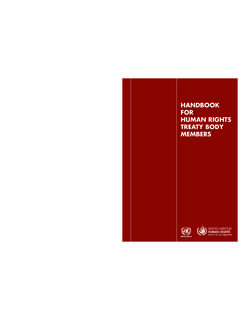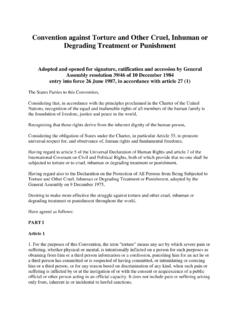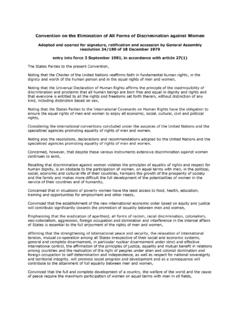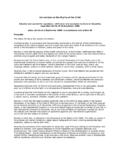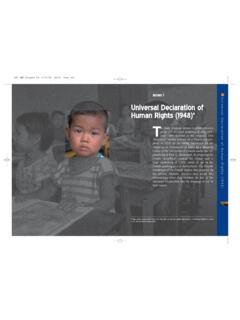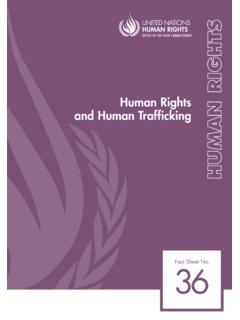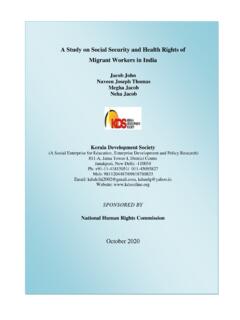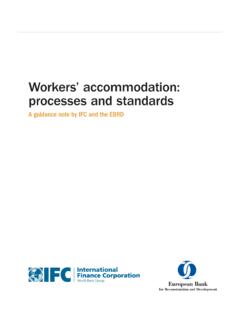Transcription of The International Convention on Migrant Workers and its ...
1 OFFICE OF THE UNITED NATIONS HIGH COMMISSIONER FOR HUMAN RIGHTS The International Convention on Migrant Workers and its Committee Fact Sheet No. 24 ( ) UNITED NATIONS New York and Geneva, 2005 NOTE The designations employed and the presentation of the material in this publication do not imply the expression of any opinion whatsoever on the part of the Secretariat of the United Nations concerning the legal status of any country, territory, city or area, or of its authorities, or concerning the delimitation of its frontiers or boundaries. * * * Material contained in this publication may be freely quoted or reprinted, provided credit is given and a copy of the publication containing the reprinted material is sent to the Office of the United Nations High Commissioner for Human Rights, Palais des Nations, 8-14 avenue de la Paix, CH-1211 Geneva 10, Switzerland.
2 Iii CONTENTS Page I. DRAFTING HISTORY OF THE Convention ..2 II. STRUCTURE AND SCOPE OF THE Convention ..4 A. Scope and definitions ..4 B. The principle of non-discrimination ..5 C. Human rights of all migrants ..5 D. Other rights of Migrant Workers and members of their families who are documented or in a regular III. THE COMMITTEE ON Migrant Workers ..10 IV. THE Convention IN THE CONTEXT OF OTHER International V. RECENT DEVELOPMENTS ..15 Useful Annexes I. International Convention on the Protection of the Rights of All Migrant Workers and Members of Their Families ..19 II. States that have signed, ratified or acceded to the International Convention on the Protection of the Rights of All Migrant Workers and Members of Their [I]t is time to take a more comprehensive look at the various dimensions of the migration issue, which now involves hundreds of millions of people and affects countries of origin, transit and destination.
3 We need to understand better the causes of International flows of people and their complex interrelationship with development (Strengthening of the United Nations: an agenda for further change, Report of the Secretary-General, A/57/387, para. 39) 1 Introduction On 1 July 2003, the International Convention on the Protection of the Rights of All Migrant Workers and Members of Their Families entered into force. By 1 October 2005, 33 States had ratified it or acceded to The Convention is a comprehensive International treaty focusing on the protection of Migrant Workers rights. It emphasizes the link between migration and human rights a policy topic that is drawing increasing attention worldwide. The Convention opens a new chapter in the history of determining the rights of Migrant Workers and ensuring that those rights are protected and respected.
4 It incorporates the results of over 30 years of discussion, including United Nations human rights studies, conclusions and recommendations of meetings of experts, and debates and resolutions in the United Nations on Migrant Workers . Like all other International human rights instruments, the Convention sets standards for the laws and the judicial and administrative procedures of individual States. Governments of States that ratify or accede to the Convention undertake to apply its provisions by adopting the necessary measures. They also undertake to ensure that Migrant Workers whose rights have been violated may seek an effective remedy. This fact sheet provides information on: The drafting history of the Convention Its structure and main features and provisions The Committee established to monitor its application How the Convention relates to other International instruments Recent developments and initiatives to promote and defend the rights of Migrant Workers 1 Algeria, Azerbaijan, Belize, Bolivia, Bosnia and Herzegovina, Burkina Faso, Cape Verde, Chile, Colombia, Ecuador, Egypt, El Salvador, Ghana, Guatemala, Guinea, Honduras, Kyrgyzstan, Lesotho, Libyan Arab Jamahiriya, Mali, Mexico, Morocco, Peru, Philippines, Senegal, Seychelles, Sri Lanka, Syrian Arab Republic, Tajikistan, Timor-Leste, Turkey, Uganda and Uruguay (see annex II).
5 2I. DRAFTING HISTORY OF THE Convention The International Convention on the Protection of the Rights of All Migrant Workers and Members of Their Families is the culmination of many years of discussions, reports and recommendations on the subject of migrants rights. The United Nations first voiced concern about the rights of Migrant Workers in 1972, when the Economic and Social Council, in its resolution 1706 (LIII), expressed alarm at the illegal transportation of labour to some European countries and at the exploitation of Workers from some African countries in conditions akin to slavery and forced labour. In the same year, the General Assembly, in its resolution 2920 (XXVII), condemned discrimination against foreign Workers and called upon Governments to end such practices and to improve reception arrangements for Migrant Workers . Following a request from the Economic and Social Council in 1973, the Sub-Commission on Prevention of Discrimination and Protection of Minorities adopted a report on the exploitation of labour through illicit and clandestine trafficking in 1976.
6 The report, drafted by its Special Rapporteur, Mrs. Halima Warzazi, recognized that there were two aspects to the problem, namely illicit and clandestine operations, on the one hand, and discriminatory treatment of Migrant Workers in host States, on the other, and recommended the drawing-up of a United Nations Convention on the rights of Migrant Workers . This recommendation was echoed at the World Conference to Combat Racism and Racial Discrimination2 in Geneva in 1978 and in General Assembly resolution 33/163 on measures to improve the situation and ensure the human rights and dignity of all Migrant Workers . Following the adoption of resolution 34/172 of 17 December 1979 by the General Assembly, a working group open to all Member States was established in 1980 to draw up a Convention , and the International organs and organizations concerned the Commission on Human Rights, the Commission for Social Development, the International Labour Organization, the United Nations Educational, Scientific and Cultural Organization, and the World Health Organization were invited to contribute to the task.
7 Reconstituted at successive annual sessions of the General Assembly, the working group finished drafting the International Convention on the Protection of the Rights of All Migrant Workers and Members of Their Families in 1990. On 18 December 1990 the International Convention on the Protection of the Rights of All Migrant Workers and Members of Their Families was adopted by the General Assembly without a vote and opened for signature by all Member States of the United Nations. 2 See Report of the World Conference to Combat Racism and Racial Discrimination, Geneva, 14-25 August 1978 (United Nations publication, Sales ). 3 migrants Rights are Human Rights: The Global Campaign for Ratification of the United Nations International Convention on the Protection of the Rights of All Migrant Workers and Members of Their Families The Steering Committee of the Global Campaign for Ratification of the United Nations International Convention on the Protection of the Rights of All Migrant Workers and Members of Their Families was first convened in 1998.
8 It is a unique alliance involving the United Nations Secretariat, intergovernmental agencies and leading International human rights, church, labour, Migrant and women s organizations.* The Steering Committee has coordinated International and national activities to publicize the Convention and raise awareness about it through its Global Campaign. Its main purpose is to promote the ratification of, or accession to, the Convention by a large number of States, and the incorporation of the Convention s standards into national laws and practices. Its work has led to a sharp increase in the number of ratifications and signatures. For example, before 1998 only 9 States had ratified the Convention , while from 1998 to 2004 another 18 did. Campaigning for ratification goes hand in hand with raising awareness of the situation of migrants in society and the often sensitive political issues involved.
9 The Global Campaign strives to achieve endorsement of the Convention from a broad cross-section of society, including public officials, political parties, trade unions, religious groups, women s organizations and so on. Only through the work of hundreds of organizations and people at the local level is the Global Campaign able to achieve such success. * Its members are: December 18, Human Rights Watch, International Catholic Migration Commission, International Confederation of Free Trade Unions, International Labour Office, International Organization for Migration, Migrant Forum in Asia, migrants Rights International , Office of the United Nations High Commissioner for Human Rights (OHCHR), Public Services International , United Nations Educational, Scientific and Cultural Organization, Women s International League for Peace and Freedom, and World Council of Churches.
10 4 II. STRUCTURE AND SCOPE OF THE Convention The entry into force of the International Convention on the Protection of the Rights of All Migrant Workers and Members of Their Families reinforces and complements a series of other provisions under the main United Nations human rights treaties (see chap. IV below). The Convention seeks to establish minimum standards that States parties should apply to Migrant Workers and members of their families, irrespective of their migratory status. The rationale behind the recognition of rights of undocumented Migrant Workers is also reaffirmed in the preamble, in which the States parties consider, inter alia, that irregular migrants are frequently exploited and face serious human rights violations and that appropriate action should be encouraged to prevent and eliminate clandestine movements and trafficking in Migrant Workers while at the same time ensuring the protection of their human rights.
